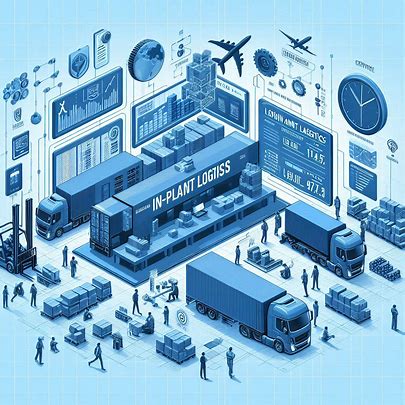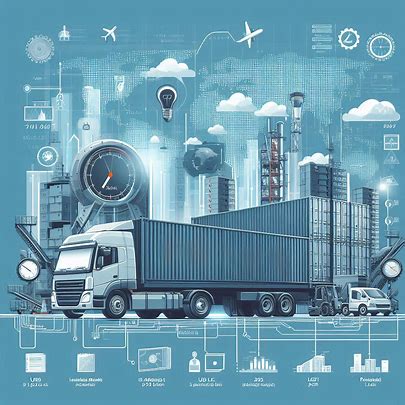In-plant logistics refers to the processes involved in managing the flow of materials and products within a manufacturing facility. It encompasses everything from raw material handling to the movement of finished goods, ensuring that the right materials are delivered to the right place at the right time. Efficient in-plant logistics is essential for just-in-time (JIT) manufacturing, minimizing waste, reducing costs, and improving productivity.

As industries around the globe shift towards automation, digitalization, and sustainability, in-plant logistics is evolving to meet the changing demands of different regions. Below is a detailed analysis of how in-plant logistics is progressing in three key regions: North America, Asia-Pacific (APAC), and Europe.
Get More Information:
https://www.marketsandmarkets.com/pdfdownloadNew.asp?id=203013862
North America: Automation and Industry 4.0
In North America, particularly in the United States and Canada, in-plant logistics is heavily influenced by the adoption of Industry 4.0 technologies and the need to address labor shortages.
Key Trends:
- Automation and Robotics: North American manufacturers are increasingly investing in automated guided vehicles (AGVs), autonomous mobile robots (AMRs), and conveyor systems to optimize material handling within plants. These technologies enhance efficiency, reduce human error, and ensure safety in high-volume operations, especially in the automotive, aerospace, and electronics sectors.
- Smart Warehousing and IoT: The integration of Internet of Things (IoT) technologies in in-plant logistics is gaining momentum. By connecting systems and devices, manufacturers can monitor material flows in real time, predict maintenance needs, and improve overall equipment efficiency (OEE). Smart warehouses are becoming a key part of in-plant logistics, with sensors and AI-driven analytics playing a major role in inventory management and material movement.
- Sustainability and Green Initiatives: Sustainability is becoming increasingly important in North American manufacturing. Companies are implementing lean manufacturing principles and optimizing in-plant logistics to reduce waste and energy consumption. Additionally, investments in electric-powered vehicles and sustainable packaging for material handling are on the rise.
Industry Focus:
- Automotive: North America’s automotive industry is leading in the adoption of automation in in-plant logistics, driven by high production volumes and the need for precise, real-time material delivery.
- Aerospace and Defense: Complex supply chains in aerospace are increasingly relying on just-in-time logistics supported by automation and IoT technologies to meet high-quality standards and tight delivery schedules.
Asia-Pacific (APAC): Growth, Flexibility, and Scalability
The Asia-Pacific region is experiencing rapid industrialization and is home to some of the world’s largest manufacturing hubs, including China, India, Japan, and South Korea. In-plant logistics in APAC is shaped by the region’s focus on scalability, cost-effectiveness, and the need to meet global supply chain demands.

Key Trends:
- Flexible Automation: In-plant logistics in APAC focuses on flexibility due to the highly diverse nature of the region’s industries. Flexible automated systems, such as mobile robots and automated forklifts, are being deployed in factories to handle a variety of materials with minimal reconfiguration. This is especially important in industries like consumer electronics and textiles, where product diversity is high, and material handling needs to be adaptable.
- Cost-Effective Solutions: Manufacturers in APAC are focused on implementing cost-effective in-plant logistics solutions to remain competitive in the global market. Low-cost automation and modular logistics systems are popular approaches, enabling factories to scale operations efficiently as demand grows.
- Rapid Technological Advancements: The APAC region is witnessing a fast-paced adoption of artificial intelligence (AI), machine learning, and IoT in material handling and logistics. Smart factories equipped with these technologies are improving production efficiency by ensuring that materials are delivered precisely when needed, reducing downtime and bottlenecks.
- Sustainability and Circular Economy: As APAC continues to grow as a manufacturing powerhouse, sustainability is becoming a significant focus, especially in countries like Japan and South Korea. Manufacturers are optimizing their logistics operations to reduce energy use and emissions, in line with global sustainability goals.
Industry Focus:
- Electronics: APAC is a global leader in electronics manufacturing, with in-plant logistics focused on precision, scalability, and handling delicate materials.
- Textiles: In countries like India and China, the textile industry benefits from scalable in-plant logistics solutions to handle large volumes of raw materials and finished goods efficiently.
Europe: Sustainability, Integration, and Lean Manufacturing
In Europe, in-plant logistics is driven by a strong focus on sustainability, lean manufacturing, and the integration of digital technologies. European manufacturers, particularly in countries like Germany, France, and the UK, are at the forefront of adopting environmentally-friendly and highly efficient logistics practices.
Key Trends:
- Sustainability and Green Logistics: Europe’s strong focus on environmental regulations and sustainability goals is shaping in-plant logistics in significant ways. Companies are implementing green logistics initiatives, which include the use of electric-powered vehicles for in-plant transportation, reduced packaging, and energy-efficient storage solutions. The emphasis on reducing carbon footprints is driving innovation in logistics processes.
- Integration of Industry 4.0 Technologies: The European manufacturing sector is deeply invested in the integration of Industry 4.0 technologies. Digital twins, cyber-physical systems, and big data analytics are increasingly being used to optimize in-plant logistics. These technologies allow for real-time tracking of material flows, enabling manufacturers to fine-tune logistics operations and improve responsiveness to production demands.
- Lean Manufacturing and JIT: Europe is a leader in implementing lean manufacturing principles, which prioritize minimizing waste and optimizing material use. In-plant logistics in Europe is designed to support just-in-time (JIT) production, ensuring that materials arrive at the exact moment they are needed in the production process, reducing inventory costs and improving efficiency.
- Collaborative Robots (Cobots): Europe is seeing a rise in the use of collaborative robots (cobots) in logistics processes. These robots work alongside human workers to perform repetitive or physically demanding tasks, such as transporting materials or managing inventory, enhancing both safety and productivity in factories.
Industry Focus:
- Automotive: European automakers are global leaders in using sustainable and lean in-plant logistics systems, integrating digital solutions to ensure precision and efficiency in material handling.
- Pharmaceuticals: The pharmaceutical industry in Europe is adopting automated and data-driven logistics systems to manage sensitive materials, ensuring compliance with stringent regulatory standards.
Conclusion: The Evolving Landscape of In-Plant Logistics
In-plant logistics is evolving rapidly across North America, APAC, and Europe, driven by regional market demands, technological advancements, and sustainability goals.
- North America is focused on automation and smart warehousing, with a particular emphasis on mitigating labor shortages and improving operational efficiency.
- APAC is leading in terms of scalability and cost-effectiveness, with flexibility being key in the region’s diverse and fast-growing manufacturing sector.
- Europe is setting the standard for sustainability and lean manufacturing, with a strong focus on integrating Industry 4.0 technologies to optimize in-plant logistics.
As global supply chains become increasingly interconnected, the importance of efficient in-plant logistics will only grow, with each region contributing its unique strengths to the global manufacturing landscape.
